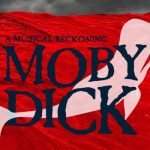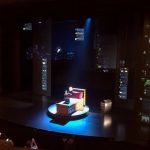Disclaimer
I have done reviews in the past of preview performances where I have given a disclaimer in which I acknowledge that I could not predict if things mentioned would still change or not, but that I would judge the performance as is. Once again I have seen a preview performance of a musical, however, since this show is being performed at the New York Theatre Workshop, a place known as an experimental lab for theater, I can not in good conscience review what I saw as a finished product. I will therefore instead talk about my experience seeing the show, how I think Sing Street compares to the movie it is based on, and what I think the intention of the creators is.
New York Theatre Workshop
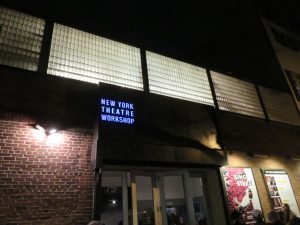
As I mentioned, Sing Street is being developed at the New York Theatre Workshop. This is a theater development lab in downtown New York notorious for supporting such productions as Angels in America, Rent, and more recently the Tony-winning Hadestown and the well-reviewed Slave Play. A lot of the creators working on Sing Street have previously developed the Tony-Winning Once at the New York Theatre Workshop, also based on a John Carney movie. I have long known about this place and when I knew I was going to New York I was hell-bent on seeing a musical production there. To be honest my initial reason was so I could say I had seen something ‘before it got big.’ As I knew the names of the shows that were developed there I expected a highly professionally designed building that housed rehearsal studios and maybe even multiple theaters. Imagine my surprise when I got there to find that it was a pretty small Blackbox theater with a small lobby. And don’t get me wrong, I was not disappointed, I was humbled. To think that all those huge, ‘household-name’ productions only used such a small space to develop. It made me all the more confident that we can start a similar venture in the Netherlands.
Sing Street the Movie
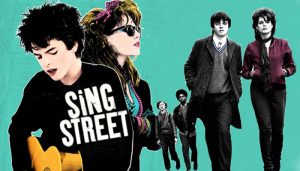
When I heard they were going to be developing Sing Street at the NYTW I immediately set an alarm for the day the tickets would go on sale. I was determined to see how this production-house worked and to see the developmental stages of a new musical. I recently saw Sing Street on a trip to Canada and was very charmed by the movie. Sing Street is a Golden-Globe nominated film written by John Carney (Academy and Tony award winner for Once) about a young schoolboy who, to impress a beautiful girl, starts a band. The film is set against the backdrop of Ireland in the 80’s, when the nation was caught in a recession and many people fled across the sea to Great Britain. In a family that is slowly falling apart Conor seeks advice from his brother Brendan for creating the music for the band. In doing so Conor discovers multiple of the then-new styles of music to express his ever changing self. He faces many problems like the fact that Raphina, the girl he likes, seems troubled and has an older boyfriend or the fact that he is being sent to a strict catholic school with Christian Brothers who discipline him. In the end he decides to leave Ireland behind and he moves to Great Britain to see if he can get a contract at a record label.
Adapting a Movie
Sing Street the musical is very different from Sing Street the movie. Normally that would be a given, since it changes form. A musical adaptation usually has to cut a lot of material from the movie. This is mostly because the movie has the camera to lead the audience, we can see close-ups in which character gets established. A musical does not usually have that luxury and it uses song to show us the characters, they have to create room for those songs and therefore they have to cut down on material. There are also obvious things that work on screen that are just hard to do in a theatrical setting, a boat skidding across the sea as an example, they also need to be dealt with.
Sing Street the Musical
the set
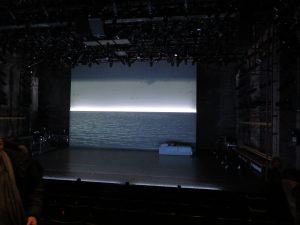
Tackling that last element, I will talk about the set design first before I delve into the specifics of the show itself. The set-design was very simple and rough and, of course, up for change. However I think the set design is the most permanent element of the production as is. The floor of the stage is separated by way of flooring, the outer rim and sides are stylized to look like brick and the inner ‘performance space’ is made up of tiles. This tiled area ends in a backdrop that consists of two canvas screens with an LED strip behind the first screen to create several colors of ‘horizon.’ Because that is what the screens are mostly used for, a photo of the sea gets projected on top of it with the top screen having clouds on it and the bottom screen the sea. The rest of the set gets suggested by lighting and furniture. The lighting creates shapes on the floor to suggest rooms and the furniture helps to visualize the interior. A sink becomes a bathroom, a bed a bedroom, a table and 5 chairs a kitchen etc. After the LED strip I think the most beautiful addition to the set are the stars. Peppered around the tile floor are tiny light dots that get carried over in the bottom part of the projection screens. These light up during one scene creating a very beautiful picture. It is also in contrast to what we usually see: stars in the sky.
The Performers
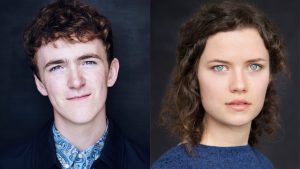
Now before I move on to talking about the book I also want to mention the performers. Brenock O’Connor stars, as one of the only Europeans, as Conor. People might now him from Game of Thrones mostly for not zig-zagging. His love interest Raphina gets played by the other actual-Irish Zara Devlin. Zara Devlin knocks her performance out of the park acting wise, but her delicate vibrato does not seem to fit the more popular style of music this show has in store for her character. Brenock on the other hand has a shockingly good voice, so good that I had to double check once or twice because it seemed like a recording. His performance of Conor is good, he plays him very realistically but he also gives him a unique character. His portrayal also definitely stands apart from the movie which is a good thing. Other standouts in the cast are Martin Moran and Anne L. Nathan as Brother Baxter and Sandra respectively. They share a scene in the second act that is simply electrifying.
The Book
Now onto the book of the musical. Enda Walsh, of Lazarus and Once fame, took John Carney’s script and he created the book for this musical. It is very noticeable that he is trying to create focus on the interpersonal relationships: family relationships, authoritarian relationships and romantic relationships. He makes the characters more relatable and realistic by cutting down the outright comedic elements from the movie and by giving certain characters more of an arc.
Sandra
The best example of this is Anne L. Nathan’s Sandra, in the movie she is mostly a comedic character. She’s the mother of one of the band-members, Eamon. She lets the kids rehearse in her living room. In the musical Sandra is a piano teacher. Because of that she more outwardly supports the band, or music, as a form of expression. It is also acknowledged that she is a single mother and that she cares deeply for her son and her pupils. The subplot between her and Barry, the school bully, is particularly interesting. Enda Walsh uses Sandra as a character to push the other characters forward on their character arcs. But Sandra also has an arc for herself, near the end of the play she confronts Brother Baxter for having contacted her son’s father instead of her for something her son did. The father works in England and doesn’t really parent the child. Having her speak out for herself was a very tense moment, but it is a beautiful cap on her character arc and it also sets up the climax of the conflict of the play perfectly.
Anne

Another character Enda seemingly expands on is Skyler Volpe’s Anne, Conor’s sister. Anne in the movie is mostly set-up to be a contrast to the two boys of the family. The oldest brother Brendan being a ‘failure,’ the Conor being set-up to be a failure because of circumstance and Anne as the middle one, the potential for success. She is in college and therefore she still has the capacity to get a job and possibly save the family with it. In the musical they more overtly explore the pressure that is put on her as the ‘only hope’ of the family, so much so that they show her crack near the end in a beautiful scene that paints a beautiful composition of multiple characters. This composition of characters is during a song called ‘Girls,’ and the staging of this song is a beautiful example of how the creators of this show have decided to use the movie’s songs.
The Songs
Since the movie itself uses the songs only in a diegetic way they had 3 options: do the same, find a way to make the songs either fit the action of a scene, or they had to write new songs that could be used in a non-diegetic way. What they ended up doing was a little bit of everything. In the movie a lot of the songs are written by the main character as an external expression of an internal conflict he’s facing, written after the events coming forth from the emotion. In the musical they just move the songs to the moment of the conflict and/or event. Since the songs are written to be connected to the conflict they still fit perfectly. What they also do in the musical, which I thought was particularly smart, is that they use the songs that have already been sung and some songs from the time-period (the 80’s) that get mentioned (Duran Duran’s ‘Rio’ comes to mind) and they make acoustic versions of them to serve as emotional interludes divorced from direct action. It kind of reminded me of how Connor McPherson uses Bob Dylan’s songs in Girl from the North Country. They aren’t a part of the plot and the text might not completely reflect the feelings of the characters but they convey the mood and emotion of the scene.
Another way in which music is used beautifully is in the fight-scenes between the parents. The first two times a radio with classical music plays and the volume melts together with their screaming and shouting to create a violent melody. But in the last scene when they announce their divorce the classical music does not spur on this violence. They stay silent.
script vs. book
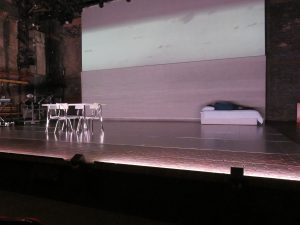
Like mentioned before I think Enda Walsh wants to highlight the interpersonal relationships. To make the characters more recognizable. In doing so, however, one of my favorite elements from the movie gets lost. In the movie the relationship between Conor and his brother gets built up because Brendan teaches him about the different styles of music. That is why Conor’s style of music and clothing evolves throughout the movie. With the amount of these scenes considerably cut down or changed some of these costume changes seem unmotivated in the show. Another casualty of the direction Enda is taking the play in is the complexity of Conor and Raphina’s relationship. In the movie it is a complex game of cat and mouse that ends up with Raphina leaving Conor in Ireland, but she gets stood up by her boyfriend and comes crawling back to Conor. Conor doesn’t feel sorry for her however and breaks up with her before his final confrontation with Brother Baxter the headmaster. To make room for the focus on the other relationships this complexity gets lost. We never see Raphina’s boyfriend, she herself decides to leave him for Conor and the confrontation with Baxter is spurred on by an unrelated event.
conclusion
So to conclude my analysis/opinion article; Sing Street has a lot of potential. The current staging of the show is very impressive and the way they are crafting the story proves very effective. The characters are very relatable and the music is thoroughly enjoyable and catchy. There are some slight problems with the book as mentioned above but they know they are creating their own version of the story and they’re not just putting the movie on stage which gives me confidence. Their allegiance is with the musical, they are not trying to copy the movie. There is however still work to be done, but it’s going to be good and I hope to be there for the next stage of development as well.
seen on: 11/26/2019, seen at: the New York Theatre Workshop. Creatives: ENDA WALSH, JOHN CARNEY, GARY CLARK, REBECCA TAICHMAN, SONYA TAYEH, BOB CROWLEY, CHRISTOPHER AKERLIND, DARRON L WEST, MARTIN LOWE Cast: MAX WILLIAM BARTOS, BRENDAN C. CALLAHAN, BILLY CARTER, ZARA DEVLIN, ILAN ESKENAZI, GUS HALPER, JAKEIM HART, MARTIN MORAN, ANNE L. NATHAN, JOHNNY NEWCOMB, BRENOCK O’CONNOR, GIAN PEREZ, SAM POON, SKYLER VOLPE, AMY WARREN
